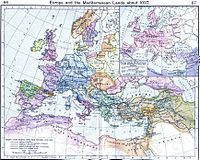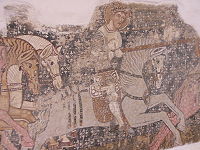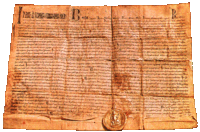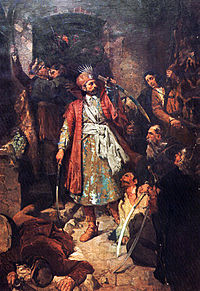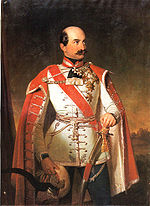- Croatia in personal union with Hungary
-
History of Croatia 
This article is part of a seriesEarly history Prehistoric Croatia Origins of the Croats White Croatia Medieval history Littoral Croatia · Pannonian Croatia · Pagania · Zachlumia · Travunia Kingdom of Croatia March of Istria Republic of Poljica Republic of Dubrovnik Kingdom of Bosnia Habsburg Empire Kingdom of Croatia Croatian Military Frontier Illyrian Provinces · Kingdom of Illyria Kingdom of Slavonia Kingdom of Dalmatia Kingdom of Croatia-Slavonia State of Slovenes, Croats, and Serbs Yugoslavia Kingdom of Yugoslavia
(Banovina of Croatia)World War II
Independent State of Croatia
Federal State of CroatiaSocialist Republic of Croatia Contemporary Croatia War of independence Republic of Croatia
Croatia Portal
 Death of the Last Croatian King, by Oton Iveković
Death of the Last Croatian King, by Oton Iveković
Kingdom of Croatia after the succession crisis become a part of Kingdom of Hungary and — depending on sources — either was incorporated (only by force) into Hungary or Croatia existed in a personal union (willingly) with Hungary.
Kingdom of Croatia and Hungary was from 1102, a personal union of two kingdoms, Kingdom of Croatia and Kingdom of Hungary, united under the Hungarian king.[1] At first, they were united under Arpad dynasty, and after its extinction, under Anjou dynasty. The last common king, came from Jagiello dynasty. The act of unions was dealt in Pacta conventa. Croatia retained its independence under native kings until 1102, when the crown passed into the hands of the Hungarian dynasty. The precise terms of this relationship later became a matter of dispute; nonetheless, even under dynastic union with Hungary, institutions of separate Croatian statehood were maintained through the Sabor (an assembly of Croatian nobles) and the ban (viceroy). In addition, the Croatian nobles retained their lands and titles.[2]
Contents
Cause of Croatia's union with Hungary
Dmitar Zvonimir (died 1089) was the King of Croatia of the Svetoslavić branch of the House of Trpimirović. He began as a ban of Slavonia in the service of Stjepan I of Croatia and then as duke of Croatia for his successor Petar Krešimir IV. Peter declared him his heir and, in late 1074 or early 1075, Dmitar Zvonimir succeeded to the Croatian throne. Zvonimir married in 1063 to his distant relative Jelena Lijepa. Jelena was born as Hungarian princess (Ilona) and was the daughter of Árpád dynasty King Bela I, sister to King Ladislaus I of Hungary. They had a son, Radovan, who died in his late teens or early twenties. After Zvonimir's death, he was succeeded by Stephen II, last of the House of Trpimirović. Stjepan's rule was relatively ineffectual and lasted less than two years. He spent most of this time in the tranquillity of the monastery of St. Stephen beneath the Pines (Sv. Stjepan pod Borovima) near Split. Stjepan II died peacefully at the beginning of 1091, without leaving an heir. Since there was no living male member of the House of Trpimirović, civil war and unrest broke out in Croatia shortly afterward.
Some Croatian nobles (especially from northern parts of Croatia) contesting the succession after the death of Zvonimir offered the Croatian throne to King Ladislaus I of Hungary. Some Croatian nobles (especially from southern parts of Croatia) refused the idea of Hungarian being kings of Croatia, and they supported Petar Svačić as their lord. Finally, in that struggle Petar Svačić was elected king by Croatian feudal lords in 1093. Petar's seat of power was based in Knin. His rule was marked by a struggle for control of the country with Hungary. During his reign he was able to expel Prince Álmos from Slavonia, and unite Croatia to the river Drava. But, Ladislaus I of Hungary used his sister's marriage to king Zvonimir as justification for his inheritance of the Croatian Crown. He attacked Kingdom of Croatia with his army. Ladislaus launched an offensive and managed to breach Croatian lines along the Drava River. The well-prepared Hungarians soon occupied the entire province of Slavonia but were halted by the Croats at Mount Gvozd (nears today's Karlovac). Shortly after his army's success, Ladislaus died (1095), leaving his nephew Coloman to continue the campaign. King Petar's troops maintained their resistance repelling Hungarian assaults for nearly two years. Coloman grew frustrated at his army's impotence and in 1097 assembled an enormous force at the eastern foot of Mount Gvozd. The subsequent offensive was brutal and absolute, resulting in Petar's death. His heroism was commemorated in the renaming of Mount Gvozd to Petrova Gora (Peter's Mountain).
Hungarians realized that conquering Croatia wouldn't be so easy. They had major success in battles over Slavonia, but when they engaged with Croatian forces on mountain terrain, they suffered great losses. Coloman saw that Dalmatia would be even harder to conquer, because it had numerous fortified towns that needed years of occupation. He started to negotiate with Croatian feudal lords. As Croatians didn't have a king any more, they saw that war with Coloman could destroy them, so they accepted to negotiate with Coloman. Five years of negotiations between Croatia's remaining noblemen and Coloman followed thereafter. Finally, in 1102, an historic settlement was reached (Pacta Conventa) by which the Croats agreed to recognise Coloman as king. In return, he promised to maintain Croatia as a separate kingdom, not to settle Croatia with Hungarians, to guarantee Croatia's self-governance under a ban (royal governor), and to respect all the rights, laws and privileges of the Croatian Kingdom.
Historians disagree whether Croatia was conquered by force, or Croatian nobles and their subjects willingly elected Coloman as their king. Either way, Coloman became king of Croatia because he was the best choice at the time, since Croatians didn't have living male member of the House of Trpimirović, or outstanding powerful noble such as Pavao I Šubić Bribirski two hundred years later.
Historical context, terms, controversies
The events surrounding the union of Croatia and Hungary are the source of a major historical controversy.[3] Croatian historians argue that the union was a personal one in the form of a shared king, while Hungarian historians insist that Croatia was conquered.[4] The significance of the debate lies in the Croatian claim to an unbroken heritage of historical statehood which is clearly compromised by the other claim.[4] The Hungarian claim was made in the 19th century during the Hungarian national reawakening, while the same argument could also be levelled about the idea of a personal union first articulated in the fourteenth century.[5] The actual nature of the relationship is inexplicable in modern terms because it varied from time to time.[5] Sometimes Croatia acted as an independent agent and at other times as a vassal of Hungary.[5] However, Croatia retained a large degree of internal independence.[5] The degree of Croatian autonomy fluctuated throughout the centuries as did its borders.[6]
According to the research of the Library of Congress a faction of Croatian nobles contesting the succession after the death of Zvonimir offered the Croatian throne to King Ladislaus I of Hungary.[7] In 1091 Ladislaus accepted, and in 1094 he founded the Zagreb bishopric, which later became the ecclestictical center of Croatia.[7] King Coloman of Hungary crushed opposition after the death of Ladislaus I of Hungary and won the crown of Dalmatia and Croatia in 1102.[7] The crowning of Coloman forged a link between the Croatian and Hungarian crowns that lasted until the end of World War I.[7] Croats have maintained for centuries that Croatia remained a sovereign state despite the voluntary union of the two crowns, but Hungarians claim that Hungary annexed Croatia outright in 1102.[7] In either case, Hungarian culture permeated Croatia, the Croatian-Hungarian border shifted often, and at times Hungary treated Croatia as a vassal state.[7] Croatia, however, had its own local governor, or ban; a privileged landowning nobility; and an assembly of nobles, the Sabor.[7]
Other sources say King Coloman established the personal union of the Kingdom of Croatia and the Kingdom of Hungary[8] by an alleged agreement called Pacta conventa. Although, the precise time and terms of Pacta Conventa later became a matter of dispute; nonetheless there was at least a non-written agreement that regulated the relations between Hungary and Croatia in approximately the same way.[9] According to Daniel Power Croatia became part of Hungary in the late 11th and early twelfth century.[10] The official entering of Croatia into a personal union with Hungary, becoming part of the Lands of the Crown of St. Stephen, had several important consequences. Institutions of separate Croatian statehood were maintained with the Sabor (parliament) and the ban (viceroy)[9] in the name of the king. A single ban governed all Croatian provinces until 1225, when the authority was split between one ban of The Whole of Slavonia and one ban of Dalmatia and Croatia. The positions were intermittently held by the same person after 1345, and officially merged back into one by 1476.
Feudalism
History of Hungary 
This article is part of a seriesPrehistory Prehistoric Pannonia Prehistoric Magyars Early history Roman Pannonia Magyar invasion Middle Ages (896–1541) Principality of Hungary
(896–1000)Medieval Kingdom of Hungary
(1000–1538)Turkish wars
(1366–1526)Early Modern history Habsburg Kingdom of Hungary
(1538–1867)Eastern Hungarian Kingdom
(1538–1570)Ottoman Hungary
(1541–1699)Principality of Transylvania
(1570–1711)Late modern period Rákóczi's War
(1703–1711)Revolution of 1848 Austria-Hungary
(1867–1918)Lands of the Crown of Saint Stephen Hungary in World War I Interwar period
(1918–41)Kingdom of Hungary
(1920-1946)World War II Contemporary history
(1946 to present)Republic of Hungary
(1946–49)People's Republic
(1949–89)Revolution of 1956 Republic of Hungary
(since 1989)Topical Church history Military history Music history Jewish history Székely people
Hungary Portal
The Hungarian king also introduced a variant of the feudal system. Large fiefs were granted to individuals who would defend them against outside incursions thereby creating a system for the defence of the entire state. However, by enabling the nobility to seize more and more economic and military power, the kingdom itself lost influence to the Frankopan, Šubić, Lacković, Nelipčić, Kačić, Kurjaković, Drašković, Babonić and other families. During this period, the Knights Templar and the Knights Hospitaller also acquired considerable property and assets in Croatia.
The later kings sought to restore their influence by giving certain privileges to the towns, making them Royal Boroughs or Free Royal Towns (similar to the Free Cities in the Holy Roman Empire), which the kings defended from the feudal lords in return for the town's support.
The princes of Bribir from the Šubić family became particularly influential during the time of Pavao Šubić Bribirski (1272–1312) who asserted control over large parts of Dalmatia, Slavonia and Bosnia during an internal conflict between the Árpád and Anjou ruling dynasties. Later, however, the Anjouvines intervened and scattered the Šubić and Babonić (1322 ad) families across the country (an important offspring being the Zrinski family). During that time, Angevian kings won a full control over Slavonia and Croatia. Hungarian power was restored in Dalmatia in 1358 AD by the Treaty of Zadar (later, in the time of reign king Sigismund I Luxembourg this province was sold to the Republic of Venice in 1409.
The Ottoman wars
As the Turkish incursion into Europe started, Croatia was once again a border area between two major forces in this part of the world. While Croats under Italian Franciscan priest fra John Capistrano contributed to the Christian victory over the Ottomans in the Siege of Belgrade of 1456, they suffered a major defeat in the battle of Krbava field (in Lika, Croatia) in 1493 and gradually lost increasing amounts of territory to the Ottoman Empire.
Pope Leo X called Croatia the forefront of Christianity (Antemurale Christianitatis) in 1519, given that several Croatian soldiers made significant contributions to the struggle against the Turks. Among them there were ban Petar Berislavić who won a victory at Dubica on the Una river in 1513, the captain of Senj and prince of Klis Petar Kružić, who defended the Klis Fortress for almost 25 years, captain Nikola Jurišić who deterred by a magnitude larger Turkish force on their way to Vienna in 1532, or ban Nikola Šubić Zrinski who helped save Pest from occupation in 1542 and fought in the Battle of Szigetvar in 1566.
The 1526 Battle of Mohács was a crucial event in which the rule of the Jagiellon dynasty was shattered by the death of King Louis II. The defeat emphasized the overall inability of the Christian feudal military to halt the Ottomans, who would remain a major threat for centuries. The Croatian historical narrative insists that the decision to join the Habsburg Empire was the result of a free choice made by the Sabor.[5] Austrian historians never claimed they conquered Croatia by force and there appears to be little reason to doubt Croatian claims about the events of 1526.[11]
Union after Battle of Mohács
The 1526 Battle of Mohács and the death of King Louis II meant the end of Hungarian authority over Croatia. Hungarian parliament has in 1526 elected János Szapolya for new king of Hungary. On other side Croatian parliament sitting at Cetin on January 1, 1527, unanimously elected Ferdinand Habsburg of Austria for King of Croatia.[12] Few years afterward both crown will be again united in Habsburgs hands and union will be restored. The Ottoman Empire further expanded in the 16th century to include most of Slavonia, western Bosnia and Lika.
Later in the same century, Croatia has been so weak that it's parliament has authorized Ferdinand Habsburg to carve out large areas of Croatia and Slavonia adjacent to the Ottoman Empire for creation of Military Frontier (Vojna Krajina, German Militaergrenze) which will be ruled directly from Vienna military headquarters.[13] The area became rather deserted and was subsequently settled by Serbs, Vlachs, Croats and Germans and others. As a result of their compulsory military service to the Habsburg Empire during conflict with the Ottoman Empire, the population in the Military Frontier was free of serfdom and enjoyed much political autonomy unlike the population living in the parts ruled by Hungary.
After the Bihać fort finally fell in 1592, only small parts of Croatia remained unconquered. The Ottoman army was successfully repelled for the first time on the territory of Croatia following the battle of Sisak in 1593. The lost territory was mostly restored, except for large parts of today's Bosnia and Herzegovina.
By the 1700s, the Ottoman Empire was driven out of Hungary , and Austria brought the empire under central control. Empress Maria Theresa of Austria was supported by the Croatians in the War of Austrian Succession of 1741–1748 and subsequently made significant contributions to Croatian matters.
With the fall of the Venetian Republic in 1797, its possessions in eastern Adriatic became subject to a dispute between France and Austria. The Habsburgs eventually secured them (by 1815) and Dalmatia and Istria became part of the empire, though they were in Cisleithania while Croatia and Slavonia were under Hungary.
Croatian romantic nationalism emerged in mid-19th century to counteract the apparent Germanization and Magyarization of Croatia. The Illyrian movement attracted a number of influential figures from 1830s on, and produced some important advances in the Croatian language and culture.
In the Revolutions of 1848 Croatia, driven by fear of Magyar nationalism, supported the Habsburg court against Hungarian revolutionary forces. However, despite the contributions of its ban Jelačić in quenching the Hungarian war of independence, Croatia, not treated any more favourably by Vienna than the Hungarians themselves, lost its domestic autonomy. In 1867 the Dual Monarchy was created; Croatian autonomy was restored in 1868 with the Croatian–Hungarian Agreement which was not particularly favourable for the Croatians.
See also
- Kingdom of Croatia before union with Hungary
- Bans of Croatia
- Ottoman Hungary
- Lands of the Crown of Saint Stephen
Footnotes
- ^ "Croatia (History)". Encarta. http://encarta.msn.com/encyclopedia_761577939_6/Croatia.html#p40.
- ^ "Croatia (History)". Britannica. http://www.britannica.com/EBchecked/topic/143561/Croatia/223953/History.
- ^ Bellamy, p.36
- ^ a b Bellamy, p.37
- ^ a b c d e Bellamy, p. 38
- ^ Singleton, p. 29
- ^ a b c d e f g Curtis, Glenn E. (1992). "A Country Study: Yugoslavia (Former) - The Croats and Their Territories". Library of Congress. http://memory.loc.gov/frd/cs/yutoc.html. Retrieved 2009-03-16.
- ^ Font, Marta:Hungarian Kingdom and Croatia in the Middle Age
- ^ a b Britannica:History of Croatia
- ^ Power, Daniel (2006). The Central Middle Ages: Europe 950-1320. Oxford University Press. p. 186. ISBN 9780199253128.
- ^ Bellamy, p. 39
- ^ R. W. SETON -WATSON:The southern Slav question and the Habsburg Monarchy page 18
- ^ Charles W. Ingrao:The Habsburg monarchy, 1618-1815 page 15
References
- Bellamy, Alex J. (2003), The Formation of Croatian National Identity: A Centuries-old Dream, Manchester University Press, ISBN 9780719065026
- Singleton, Frederick Bernard (1985). A short history of the Yugoslav peoples. Cambridge University Press. ISBN 9780521274852.
- Curtis, Glenn E. (1992). "A Country Study: Yugoslavia (Former) - The Croats and Their Territories". Library of Congress. http://memory.loc.gov/frd/cs/yutoc.html. Retrieved 2009-03-16.
Wikimedia Foundation. 2010.

